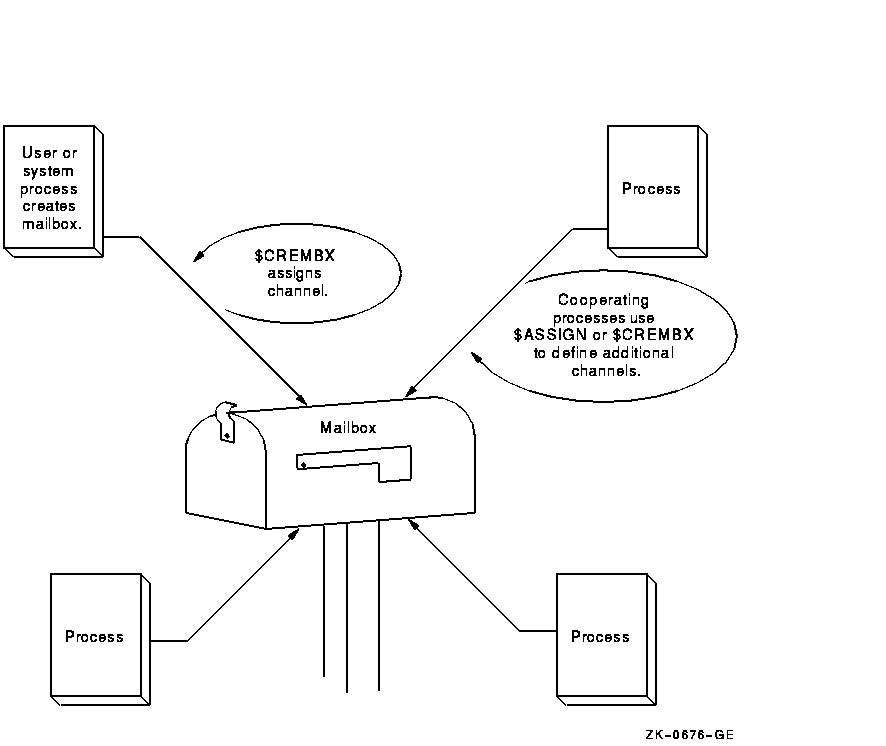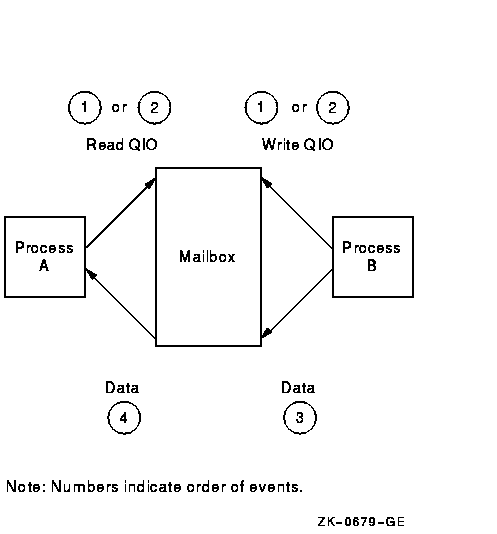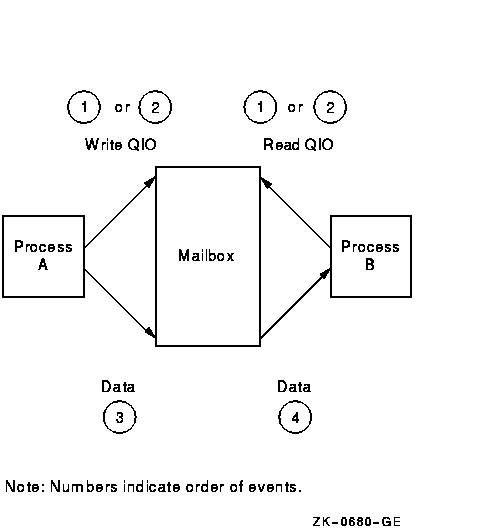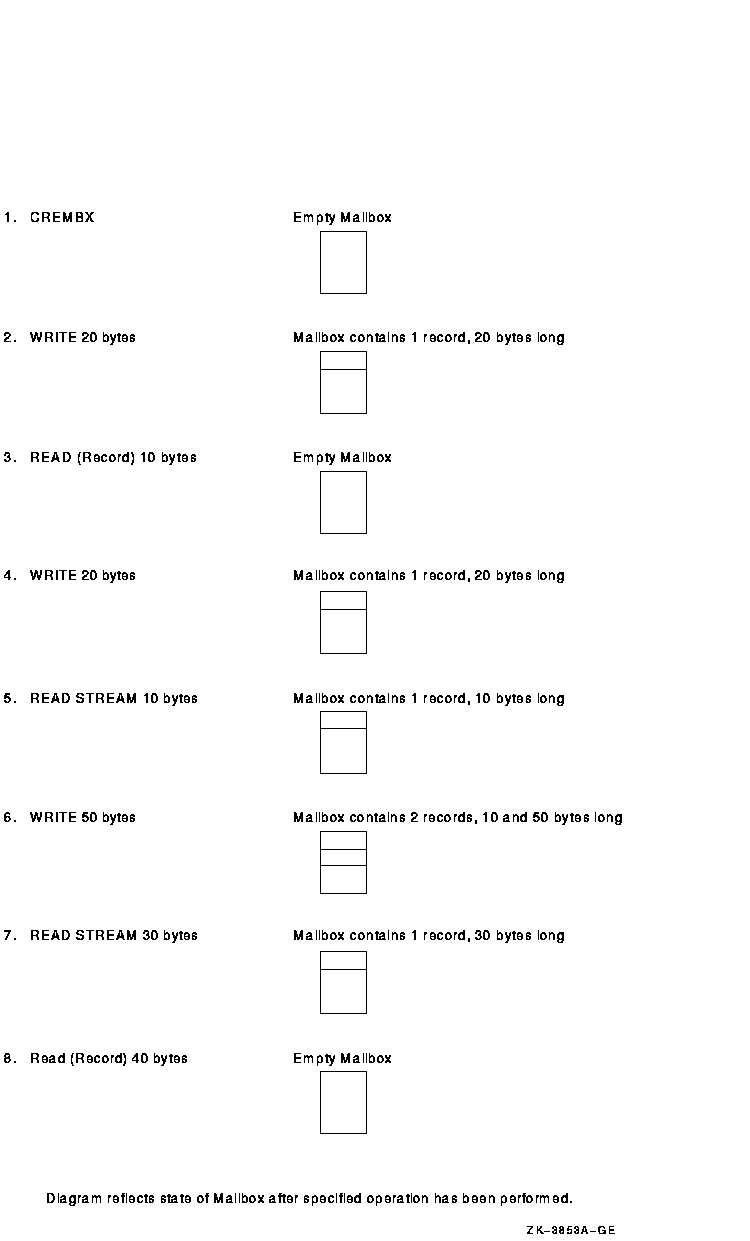OpenVMS I/O User's Reference Manual
Chapter 4
Mailbox DriverThe operating system supports a virtual device, called a mailbox, thatis used for communication between processes. Mailboxes provide acontrolled, synchronized method for processes to exchange data.Although mailboxes transfer information much like other I/O devices,they are not hardware devices. Rather, mailboxes are asoftware-implemented way to perform read and write operations betweenprocesses. The OpenVMS Programming Concepts Manual and the OpenVMS System Services Reference Manual contain additional informationabout using mailboxes.4.1 Mailbox Operations This section describes the following mailbox operations: - Creating mailboxes
- Deleting mailboxes
- Protecting mailboxes
4.1.1 Creating MailboxesTo create a mailbox and assign a channel and logical name to it, aprocess uses the Create Mailbox and Assign Channel ($CREMBX) systemservice. A logical name can optionally be associated with the mailbox.If a logical name is specified for the mailbox, the system enters thelogical name in a logical name table and gives it an equivalence nameof MBAn, where n is a unique unit number. $CREMBX also establishes the characteristics of the mailbox. Thesecharacteristics include a protection mask, a permanence indicator,maximum message size, buffer quota, and direction in which I/O can beperformed (read, write, or read/write). A mailbox is created as eithertemporary or permanent; both types require privilege to create.Applications and restrictions on how to use temporary and permanentmailboxes are described in the following sections. (Refer to theOpenVMS System Services Reference Manual for additional information on creating mailboxes.) Other processes can assign additional channels to a mailbox usingeither the $CREMBX or the Assign I/O Channel ($ASSIGN) system service.The mailbox is identified by its logical name both when it is createdand when it is assigned channels by cooperating processes. Channelsassigned to the mailbox can specify the direction that I/O can beperformed on the channel. Figure 4-1 shows the use of $CREMBX and $ASSIGN. Figure 4-1 Multiple Mailbox Channels
 If sufficient dynamic memory for the mailbox data structure is notavailable when a mailbox is created, a resource wait occurs if resourcewait mode is enabled. When a mailbox is created, a certain amount of space is specified forbuffering messages that have been written to the mailbox but have notyet been read. The bufquo argument to the $CREMBXsystem service specifies this amount or quota. If that argument isomitted, its value defaults to the system parameter DEFMBXBUFQUO. A message written to a mailbox, in the absence of an outstanding readrequest, is queued to the mailbox, and the size of the message (the QIOP2 argument) is subtracted from the available buffering space. Afterthe message is read, it is added back to the available buffering space. If a process attempts to write to a mailbox that is full or hasinsufficient buffering space and if the process has resource waitenabled (which is the default case), the process is placed inmiscellaneous resource wait mode until sufficient space is available inthe mailbox. If resource wait is not enabled, the I/O completes withthe status return SS$_MBFULL in the I/O status block (IOSB). Channels can be assigned to mailboxes as bidirectional (read/write),read only, or write only. This allows for greater synchronizationbetween users of the mailbox. To specify a unidirectional channel tothe mailbox, specify the flags argument for the$CREMBX or $ASSIGN system services. The flags argument is a longword bit mask that enablesyou to specify that the channel assigned to the mailbox is a read-onlyor write-only channel. If the flags argument is notspecified, the default channel behavior is read/write. A channelassigned to the mailbox as read only is considered a reader. A channelassigned to the mailbox as write only is considered a writer. A channelassigned to the mailbox as read/write is considered both a reader and awriter. For the $ASSIGN system service, the $AGNDEF macro defines a symbolicname for each flag bit. These flags are as follows: - AGN$M_READONLY---When this flag is specified, $ASSIGN assigns a read-only channel to the mailbox device. An attempt to issue a $QIO WRITE operation on the mailbox channel causes an illegal I/O operation error.
- AGN$M_WRITEONLY---When this flag is specified, $ASSIGN assigns a write only channel to the mailbox device. An attempt to issue a $QIO READ operation on the mailbox channel causes an illegal I/O operation error.
For the $CREMBX system service, the $CMBDEF macro defines a symbolicname for each flag bit. These flags are as follows: - CMB$M_READONLY---When this flag is specified, $CREMBX assigns a read-only channel to the mailbox device. An attempt to issue a $QIO WRITE operation on the mailbox channel causes an illegal I/O operation error.
- CMB$M_WRITEONLY---When this flag is specified, $CREMBX assigns a write-only channel to the mailbox device. An attempt to issue a $QIO READ operation on the mailbox channel causes an illegal I/O operation error.
Refer to the OpenVMS System Services Reference Manual for a syntax description of the $CREMBX and$ASSIGN system services. The programming examples at the end of this section ( Section 4.5)show mailbox creation, interprocess communication, and synchronization.4.1.2 Deleting Mailboxes As each process finishes using a mailbox, it deassigns the channelusing the Deassign I/O Channel ($DASSGN) system service. Temporarymailboxes or permanent mailboxes that have been marked for deletion areactually deleted when no more channels are assigned to them. If a mailbox channel is deassigned, any incomplete I/O requests on themailbox channel for the process deassigning the channel are removed. Permanent mailboxes that have not been marked for deletion must beexplicitly deleted using the Delete Mailbox ($DELMBX) system service.An explicit deletion can occur at any time. As is true for temporarymailboxes, the mailbox is deleted when no processes have channelsassigned to it. When a temporary mailbox is deleted, its message buffer quota isreturned to the process that created it. (No quota charge is made forpermanent mailboxes.)4.1.3 Mailbox Message Format There is no standardized format for mailbox messages and none isimposed on users.4.1.4 Mailbox Protection Mailboxes (both temporary and permanent) are protected by a code, ormask, that is similar to the code used in protecting volumes. As withvolumes, four types of users (defined by UIC) can gain access to amailbox: SYSTEM, OWNER, GROUP, and WORLD. However, only three types ofaccess---logical I/O, read, and write---are meaningful to users of amailbox. Therefore, when creating a mailbox, you can specify logicalI/O, read, and write access to the mailbox separately for each type ofuser. Logical I/O access is required for any mailbox operation. The setprotection function modifier provides additional control of mailboxaccess (see Section 4.3.6). For additional information on temporary mailboxes and mailboxprotection, see the description of the $CREMBX system service in theOpenVMS System Services Reference Manual.4.2 Mailbox Driver Device Information You can obtain information on mailbox characteristics by using the GetDevice/Volume Information ($GETDVI) system service. (Refer to theOpenVMS System Services Reference Manual.) $GETDVI returns mailbox characteristics when you specify the item codeDVI$_DEVCHAR. Table 4-1 lists these characteristics, which aredefined by the $DEVDEF macro. Table 4-1 Mailbox Characteristics | Characteristic1 | Meaning | | Dynamic Bits (Conditionally Set) | | DEV$M_SHR | Device is shareable. | | DEV$M_AVL | Device is available. | | Static Bits (Always Set) | | DEV$M_REC | Device is record-oriented. | | DEV$M_IDV | Device is capable of input. | | DEV$M_ODV | Device is capable of output. | | DEV$M_MBX | Device is a mailbox. |
1Defined by the $DEVDEF macro.
DVI$_DEVCLASS and DVI$_DEVTYPE return the device class and device typenames, which are defined by the $DCDEF macro. The device class formailboxes is DC$_MAILBOX. The device type is DT$_MBX (or DT$_SHRMBX ifthe mailbox is a shared memory mailbox). DVI$_DEVBUFSIZ returns thebuffer size, which is the maximum message size in bytes. DVI$_DEVDEPEND returns a longword field in which the two low-orderbytes contain the number of messages in the mailbox. (The twohigh-order bytes are not used and should be ignored.) DVI$_UNIT returns the mailbox unit number. Using mailbox to hold atermination message for a subprocess or a detached process requiresthat the parent process obtain this number to pass to thembxunt argument of the $CREPRC system service.4.3 Mailbox Function Codes The mailbox I/O functions are read, write, write end-of-file, setattention AST, wait for writer/reader, and get mailbox information. No buffered I/O byte count quota checking is performed on mailbox I/Omessages. Instead, the byte count or buffer quota of the mailbox ischecked for sufficient space to buffer the message being sent. Thebuffered I/O quota and AST quota are also checked.4.3.1 Read Read mailbox functions are used to obtain messages written to themailbox. The operating system provides the following mailbox functioncodes: - IO$_READVBLK---Read virtual block
- IO$_READLBLK---Read logical block
- IO$_READPBLK---Read physical block
IO$_READLBLK, IO$_READVBLK, and IO$_READPBLK all perform the sameoperation. To issue a read request, a process can specify any of theread function codes. The following device- or function-dependent arguments are used withthese codes: - P1---The starting virtual address of the buffer that is to receive the message. If P2 specifies a zero-length buffer, P1 is ignored. On OpenVSM Alpha, P1 can be a 64-bit address.
- P2---The size of the buffer in bytes (limited by the maximum message size for the mailbox). A zero-length buffer may be specified. If a message longer than the buffer is read, the alternate success status SS$_BUFFEROVFis returned in the I/O status block. In such cases, the message istruncated to fit the buffer. The driver does not provide a means forrecovering the deleted portion of the message.
The following function modifiers can be specified with a read request: Reads of 0 bytes are handled differently depending on which functionalmodifiers are specified. If IO$M_STREAM is specified, then the $QIOreturns SS$_NORMAL with 0 bytes read. The contents of the mailboxremain exactly as they were before the $QIO was issued. A $QIO READSTREAM of 0 bytes does not remove a 0 byte record, nor does it removean end-of-file marker. If IO$M_STREAM is not specified, then $QIOreturns one of the following: - SS$_NORMAL (if 0 bytes were written with the corresponding $QIO WRITE performed)
- SS$_BUFFEROVF (if the corresponding $QIO WRITE wrote more than 0 bytes with 0 bytes read)
- SS$_ENDOFFILE (if a WRITEOF function was performed as the corresponding $QIO write function)
For a 0-byte nonstream read, a record is actually removed from themailbox in order to meet the $QIO READ request. Note that the use ofthe word "immediately" does not imply that synchronization ofthe $QIO request should not be performed. Figure 4-3 shows the read mailbox functions. In this figure, ProcessA reads a mailbox message written by Process B. As the figureindicates, a mailbox read request requires a corresponding mailboxwrite request (except in the case of an error). The requests can bemade in any sequence; the read request can either precede or follow thewrite request. Figure 4-3 Read Mailbox
 If Process A issues a read request before Process B issues a writerequest, one of two events can occur. If Process A did not specify thefunction modifier IO$M_NOW, Process A's request is queued beforeProcess B issues the write request. When Process B's write requestoccurs, the data is transferred from Process B, through the systembuffers, to Process A to complete the I/O operation. However, if Process A did specify the IO$M_NOW function modifier, theread operation is completed immediately. That is, no data istransferred from Process B to Process A, and Process A's request is notqueued until Process B issues the write request. In this case, the I/Ostatus returned to Process A is SS$_ENDOFFILE. If Process B sends a message (with no function modifier; seeSection 4.3.2) before Process A issues a read request (with or withouta function modifier), Process A finds a message in the mailbox. Thedata is transferred and the I/O operation is completed immediately,regardless of whether IO$M_NOW is specified on the read request.4.3.2 Write Write mailbox functions are used to transfer data from a process to amailbox. The operating system provides the following mailbox functioncodes: - IO$_WRITEVBLK---Write virtual block
- IO$_WRITELBLK---Write logical block
- IO$_WRITEPBLK---Write physical block
IO$_WRITEVBLK, IO$_WRITELBLK, and IO$_WRITEPBLK all perform the sameoperation. To issue a write request, a process can specify any of thewrite function codes. These function codes take the following device- or function-dependentarguments: - P1---The starting virtual address of the buffer that contains the message being written. If P2 specifies a zero-length buffer, P1 is ignored. On OpenVMS Alpha, P1 can be a 64-bit address.
- P2---The size of the buffer in bytes (limited by the maximum message size for the mailbox). A zero-length buffer produces a zero-length message to be read by the mailbox reader.
The following function modifiers can be specified with a write request: - IO$M_READERCHECK---Completes the I/O operation immediately, with SS$_NOREADER status, if no read channels are assigned to the mailbox. If a $QIO WRITE with IO$M_READERCHECK is issued and is outstanding and all read channels assigned to the mailbox are then deassigned, the $QIO completes with SS$_NOREADER status. IO$M_READERCHECK is ignored if the channel on which it is issued is bidirectional read/write, because there is always a reader assigned. If SS$_NOREADER is returned for a write request, the $QIO WRITE operation does not place any data in the mailbox. If SS$_NOREADER is returned for a write end-of-file message request, the $QIO WRITE operation does not place the end-of-file marker in the mailbox.
- IO$M_NOW---Completes the I/O operation immediately without waiting for another process to read the mailbox message. $QIO WRITE, without IO$M_NOW specified, does not complete until the data is read. $QIO WRITE NOW completes when the data is in the mailbox. If both IO$M_READERCHECK and IO$M_NOW are specified and no read channel is assigned to the mailbox, a status of SS$_NOREADER is returned and the data is not placed in the mailbox. If a read channel is assigned, the IO$M_READERCHECK modifier is ignored.
- IO$M_NORSWAIT---If the mailbox is full, the I/O operation fails with a status return of SS$_MBFULL rather than placing the process in resource wait mode. Note that IO$M_NORSWAIT does not disable resource waits that may occur elsewhere in the $QIO operation. For example, IO$M_NORSWAIT does not affect any resource waiting that occurs when I/O processing routines try to allocate an I/O request packet while passing the I/O request to the mailbox driver.
A $QIO WRITE of 0 bytes causes a 0-byte long message to be placed inthe mailbox. When this data is read by a $QIO READ without IO$M_STREAMspecified, the $QIO READ returns an SS$_NORMAL status and 0 bytes. Whenthis data is read by a $QIO READ STREAM in an attempt to read P2 bytes(P2 being greater than 0), the data is ignored. However, a $QIO READSTREAM of 0 bytes has no effect on the mailbox. A $QIO WRITEREADERCHECK of 0 bytes, when no read channel is assigned to themailbox, returns an SS$_NOREADER error and the 0-byte record is notplaced in the mailbox. A message that is 0 bytes long is charged 1 byteof mailbox BUFQUO. Figure 4-4 shows the write mailbox function. In this figure, ProcessA writes a message to be read by Process B. As in the read requestexample, a mailbox write request requires a corresponding mailbox readrequest (unless an error occurs) and the requests can be made in anysequence. If Process A issues a write request before Process B issues a readrequest, one of two events can occur. If Process A did not specify thefunction modifier IO$M_NOW, Process A's write request is queued beforeProcess B issues a read request. When this request occurs, the data istransferred from Process A to Process B to complete the I/O operation. However, if Process A did specify the IO$M_NOW function modifier, thewrite operation is completed immediately. The data is available toProcess B and is transferred when Process B issues a read request. If Process B issues a read request (with no function modifier) beforeProcess A issues a write request (with or without the functionmodifier), Process A finds a request in the mailbox. The data istransferred and the I/O operation is completed immediately. Figure 4-4 Write Mailbox
 4.3.3 Write End-of-File MessageWrite end-of-file message functions are used to insert a specialmessage in the mailbox. The process that reads the end-of-file messageis returned the status code SS$_ENDOFFILEin the I/O status block. The message count of the Get MailboxInformation function reflects this end-of-file message; however, themailbox byte count of this function does not include end-of-filemarkers. An end-of-file message is charged 1 byte of mailbox BUFQUO. This function takes no arguments. The operating system provides thefollowing function code: IO$_WRITEOF---Write end-of-file message The following function modifiers can be specified with a writeend-of-file request: - IO$M_READERCHECK---Completes the I/O operation immediately, with SS$_NOREADER status, if no read channels are assigned to the mailbox. If a $QIO WRITEOF with IO$M_READERCHECK is issued and is outstanding and all read channels assigned to the mailbox are then deassigned, the $QIO completes with SS$_NOREADER status. IO$M_READERCHECK is ignored if the channel on which it is issued is bidirectional read/write, because there is always a reader assigned. If SS$_NOREADER is returned for a write end-of-file message request, the $QIO WRITEOF operation does not place the end-of-file marker in the mailbox.
- IO$M_NOW---Completes the I/O operation immediately without waiting for another process to read the mailbox message. If both IO$M_READERCHECK and IO$M_NOW are specified, and no read channel is assigned to the mailbox, a status of SS$_NOREADER is returned and the end-of-file message is not placed in the mailbox.
- IO$M_NORSWAIT---If the mailbox is full, the I/O operation fails with a status return of SS$_MBFULL instead of placing the process in resource wait mode. Note that IO$M_NORSWAIT does not disable resource waits that may occur elsewhere in the $QIO operation. For example, IO$M_NORSWAIT does not affect any resource waiting that occurs when I/O processing routines try to allocate an I/O request packet while passing the I/O request to the mailbox driver.
|


